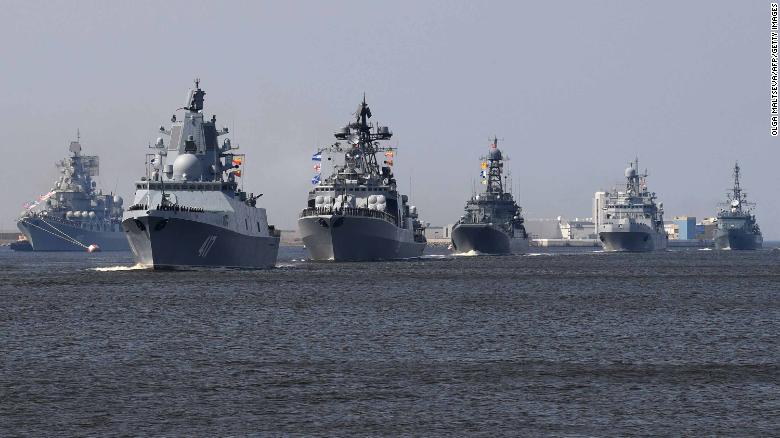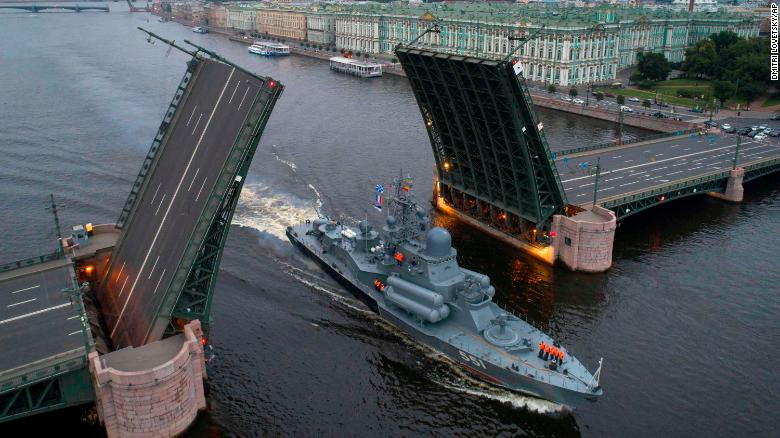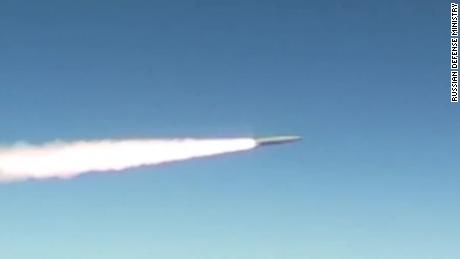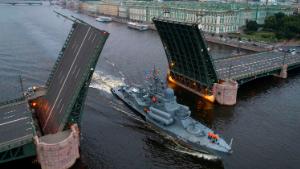Russia's navy parade: Big show but how much substance?
(CNN)Russia plans to show off its naval might on Sunday, sending 40 warships through waters near St. Petersburg in a display that promises to be strong on optics but one that may mask key weaknesses.
This year's version of the country's annual Navy Day parade is expected to feature the first public appearance of Russia's new stealth frigate, the Admiral Gorshkov. State-run news agency Tass reported the 4,500-ton warship is expected to be delivered to the navy on Saturday.
The Admiral Gorshkov is the lead ship of six of the type planned to become part of the Russian fleet by 2025, according to Tass.

The Russian Navy frigate Admiral Gorshkov, second left, sails with other warships in rehearsal for Sunday's Navy Day parade in St. Petersburg.
Defense Minister Russian Defense Minister Sergei Shoigu calls the new class of frigates the "mainstay" of the Russian fleet for years to come, Tass said.
Analysts say Groshkov-class frigates will be fast and formidable.
"The new frigate is incredibly well armed for such a small warship," analyst Paul Schwartz of the Center for Strategic and International Studies (CSIS) wrote in a 2016 study of the program, adding the frigate "would add significant combat capability to the fleet."
"It's a significant upgrade over its predecessors," said Carl Schuster, a former director of operations at the US Pacific Command's Joint Intelligence Center, who points out that the new Russian frigates will carry supersonic anti-ship cruise missiles that can find their targets much more quickly than their US counterparts.
That gives the Admiral Gorshkov-class an advantage over the US ships, including the much heavier Arleigh Burke-class guided-missile destroyers and the US littoral combat ships, which are of a similar size but more lightly armed than the Gorshkov, said Schuster.

The Oryol nuclear-powered missile-carrying submarine will be the biggest vessel in this year's Russian Navy Day parade.
Other notable ships in Sunday's parade include the brand-new amphibious assault ship Ivan Gren -- capable of carrying 13 main battle tanks -- the 10,000-ton guided missile cruiser Marshal Ustinov, and the guided-missile submarine Oryol, at 24,000 tons the largest vessel in the parade, according to Tass.
While those ships join three dozen others in the waters off St. Petersburg, noticeably absent will be the country's lone aircraft carrier, the Admiral Kuznetsov.
The 58,000-ton carrier went in for repairs and refit in May, more than a year after it returned from a mission off Syria that saw it spewing thick black smoke while at sea and also losing two of its 15 aircraft to crashes.
The Russian carrier is not expected to be back on active duty until 2021, Tass reports.

The Russian aircraft carrier Admiral Kuznetsov is seen in 2016.
Schuster said that shows a problem with the Russian navy -- maintenance.
"The Russians typically focus on construction first, operations a distant second, training third and maintenance a very distant fourth," the former US Navy officer said.
"The Kuznetzov needs far more upgrading and maintenance than the Russians have publicly stated they will undertake. It means she will be approaching obsolescence when she departs the yards in 2021," said Schuster, now a professor at Hawaii Pacific University.
Asked about claims from Russia's deputy defense minister this month that Moscow will this year add 19 ships to its fleet of about 280 ships, Schuster was circumspect.
"The Russians count every ship commissioned, including patrol craft and units coming out of shipyard overhaul," he said. "It gives the impression of a major buildup, but only about six of them will be modern warships."
And Russia's shipbuilding has its share of problems. Tass reported in early July that the delivery of the second frigate in the Gorshkov class, the Admiral Kasatonov, will be delayed by almost a year. The report cited "engine problems" with the frigates.

A Russian warship sails past the Dvortsovy drawbridge rising above the Neva River during rehearsals for the Navy Day parade in St. Petersburg.
In a May 2018 research paper, Britain's Chatham House noted the delays in the Gorshkov class, among a wide range of shortcomings in Russia's attempt to build its naval fleet, especially surface forces.
For the next decade Russia's navy will be relying on older, large vessels undergoing constant renovation and overhaul -- as in the case of the Kuznetzov -- and smaller, newer vessel facing production challenges like the Gorshkov, the report said.
Schuster said even when ships join the Russian fleet, that doesn't mean they are necessarily something for foes to worry about.
"Russia has always been good at building but typically put less than 10% of their ships at sea at any one time," he said. "The ships that deploy spend more time at anchorage than operating at sea."
Though Russian press this month has featured numerous stories touting the country's naval buildup and previewing Sunday's parade, the event pales compared to the 2017 version. That was celebrated with events in all corners of the sprawling country, from Vladivostok in the west to Baltiysk, the western base of Russia's Baltic Fleet.

Play Video
Russia releases video of new nuclear weapons
The year since has also seen Russian President Vladimir Putin putting a new emphasis on weapons development.
In March, Putin boasted new weaponry he claimed will render NATO defenses "completely useless" while delivering a warning to the world about Russia's resurgent military might.
And shortly after this month's summit with US President Donald Trump, Putin's Defense Ministry released a series of videos on YouTube highlighting some of the same weapons from his March speech.
News Courtesy: www.cnn.com











